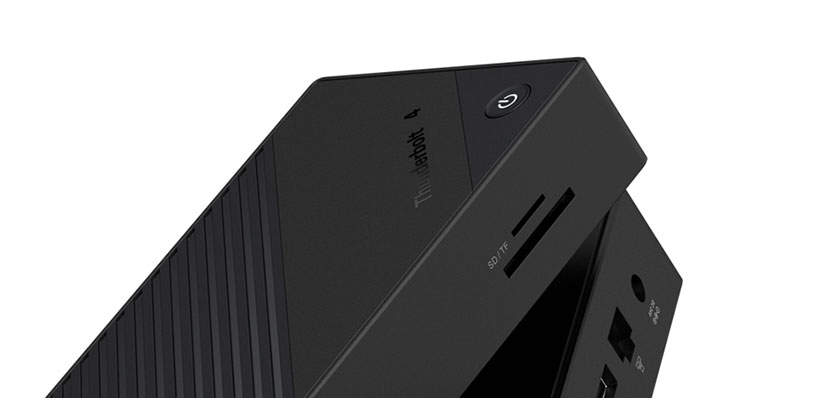When it comes to peripheral connectivity on modern PCs, you're likely to find at least two of these three ports: USB-A, USB-C, and Thunderbolt. Of course, some PCs will have varying combinations of all three. But since Thunderbolt 4 was formally announced in early 2020 by Intel and began shipping in 11th generation Core-based laptops, the situation seems to have changed, Thunderbolt 4 can most simply be described as the port to end all ports.
Thunderbolt 4 is an upgraded cable connection interface from Intel capable of powering your devices, transferring data, and displaying a video source to an external monitor all at once — all with just one port. Not only does Thunderbolt 4 free up ports by delivering fast transfer speeds, charging, and video output over a single connection, but it can upgrade your overall setup (and clean up a desk riddled with cables).

(image from Intel)
In addition, Thunderbolt 4 is backward compatible with all previous versions (although you'll need adapters for the original Thunderbolt and Thunderbolt 2) and all prior USB standards. This is the new best way to connect external devices like high-speed storage, high-res monitors, and docking stations. A multiport Thunderbolt 4 dock can connect via a Thunderbolt 4 cable to a single Thunderbolt 4 port on your PC.
Increase the number of devices you can connect to a laptop or desktop PC with a Thunderbolt 4 dock. For example, connect a gaming keyboard, a wired gaming mouse, external monitor, and SSD to a dock, and then to a PC with a single Thunderbolt 4 cable. Just how many — and what kind — of ports are supported will vary depending on the dock’s make and model. Most Thunderbolt 4 docks increase the number of Thunderbolt 4 ports available and frequently feature additional ports for USB 3.0 Type-A, DisplayPort, and audio.
With a bandwidth of 40Gbps, Thunderbolt 4 ports make it easy to connect high performance devices — such as a gaming monitor and a high-speed SSD — and use them at their intended speeds without overloading the port's capacity. Because the bandwidth is bidirectional, the outgoing video signal won't conflict with incoming data from peripherals or a storage drive.
Use a dock to keep your gaming space organized, with all of your gaming accessories plugging into a central hub instead of connecting directly to the PC itself. With just one cable going from the dock to your PC, your gaming area stays clean and free of clutter.
Simply detach one cable instead of three or four when you want to relocate with your laptop.
Thunderbolt 4 has specifically been designed to make connecting all devices easier, meaning your work setup won't need a device overhaul. You'll find that Thunderbolt 4 isn't even that much of an upgrade from Thunderbolt 3, as many PC users may not even notice a difference. That said, Thunderbolt 4 has a lot to bring to the table. More like multiple tables, though, as it's all about connectivity with speed and ease.

Thunderbolt 4 13-in-1 Docking Station 1225
Single Monitor Arm with Thunderbolt 4 Dock
...
Contact Us to get more new products information.
Thunderbolt 4 uses the USB-C connector, and it's backward compatible with all USB standards. So, in the sense of (for example) whether you can connect your USB-C custom flash drives to your laptop's Thunderbolt port, the two are the same.
Thunderbolt 4 is the latest version of Intel's Thunderbolt line. It is backwards compatible with Thunderbolt 3 and USB-C, and has a range of benefits. All certified Thunderbolt 4 cables work with everything, including USB4, USB 3.2, USB 3.1, and even USB 2.0 – no matter what their length.
Thunderbolt 4 and USB4 have the same specs, but Thunderbolt 4 is more reliable with tighter minimum specs. USB4's minimum speed goes as low as 20Gbps (or as high as 40Gbps), whereas Thunderbolt 4's minimum speed is stuck firmly at 40Gbps. Minimum power through ports is also halved, with 7.5W instead of 15W. You're only guaranteed for one external display with USB4, whereas Thunderbolt 4 offers dual 4K displays at 60Hz as a minimum. The takeaway here is that USB4 and Thunderbolt 4 are closely linked, with the latter delivering a more solid foundation for expected performance.
|
Minimum Speed |
Maximum Speed | Minimum Video Requirements | Minimum Data Requirements | |
| Thunderbolt 4 | 40Gbps | 40Gbps | Two 4K display @60Hz | 32Gbps |
| USB4 | 20Gbps | 40Gbps | One display @60Hz | 16Gbps |
You can connect external monitors, Thunderbolt, and USB devices with a single Thunderbolt 4 cable.